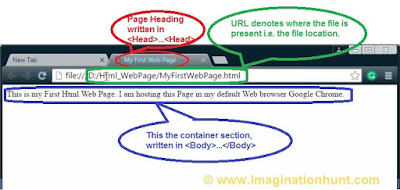In our previous blog, we have given some basic introduction to HTML Language. Please read if you are new to Web Programming.
Before going through the blog, you need
to have a text editor/notepad and a web browser.
To open a notepad. Read Blog How to open notepad?
In this blog, we are going to create our
first HTML Web page. For this, we need to understand the very first 4 basic
HTML tags. And those four basic tags are:
1) html:
<html>…</html> is the container tag. It describes an HTML document.
2) head:
<head>...</head> tag describes the page heading section. It is
invisible on the webpage.
3) title:
<title>…</title> tag is used to put the title of the web page in
the browser. This is the only tag which is visible in the head section/tag.
4) body:
<body>…</body> tag is a container for visible content on the
browser.
Point to remember
1) Html is all about tags.
2) Every tag must be enclosed with
opening and closing angular brackets (For e.g. < >).
3) In Html, every tag that starts should
necessarily be ended with the same name plus with a backward slash character
(for e.g. <abc>……</abc>)
4) Html web pages are written over text
document or Notepad.
5) Save as the file by giving the filename
with .html or .htm extension.
6) Open with the file in any browser
(for e.g. Microsoft Edge or Google Chrome)
You can develop your first HTML Web page
by watching the below given .GIF Image.
OR to create your first Web Page, follow
these steps: -
Step-1) Start typing your HTML code
on the notepad or text editor.
Practical Implementation:
<html>
<head>
<title>
My
First Web Page
</title>
</head>
<body>
This is my First Html Web Page. I am
hosting this Page in my default Web browser Google Chrome.
</body>
</html>
Step-2) Follow Point no. 5 from above explained - point to remember section.
Step-3) Follow Point no. 6 from point to remember.
Output: The output is shown in below
figure.
For any query, comment us below.
Previous - What is HTML?
Related Questions: -
Q-1 Which of them are text editor?
A) Notepad++
B) Sublime Text
C) Vim
D) Emacs
E) Neither C nor D
F) All (A), (B), (C), (D)
Ans- Option (F).
Q-2 How to comment HTML code?
A) <% … %>
B) <%-- … --%>
C) <!-- … -->
D) /* … */
Ans- Option(C).
Keep learning and sharing...

 Technologies
Technologies


No comments:
Post a Comment